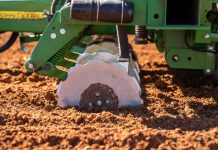
SA Graan/Grain-medewerker
Investment in plant breeding and the development of innovative technologies and breeding techniques that help breeders develop improved crops, are two of the key elements that enable producers to realise good yields and, in the end, achieve food security globally.
Throughout the ages, plant breeders have made use of the natural variation in plant genomes that plants use to adapt to their changing environments, in breeding programmes. Modern varieties of maize, wheat and rice are excellent examples of the end result of human selection in agricultural crops. Improvement of the most desirable agronomic and yield-enhancing traits has resulted in crop varieties that are safe, robust, nutritious, and capable of growing under a wide range of environmental conditions.
According to Dr Lukeshni Chetty, general manager at SANSOR (South African National Seed Organisation), it is crucial to continuously increase and secure food production on arable land that is available for agriculture without increasing the demand for additional resources.
‘Climate change poses a major challenge, with increasing temperatures, more frequent droughts, flooding, and other extreme weather phenomena impacting agriculture globally. Reconciling sustainability with agricultural productivity in the face of climate change relies strongly on the development of resilient, high-yielding crops of superior nutritional value that can be grown more resource efficiently,’ Dr Chetty says.
‘Crops should continue to withstand changing environmental conditions, as well as disease and pest pressures in future. This is where plant breeding comes into play,’ says Dr Magdeleen Cilliers, policy and research manager at SANSOR.
‘Plant breeders have the important responsibility of ensuring new varieties of field crops and vegetables that can help producers realise the best yields possible using less inputs that can withstand abiotic stress factors such as droughts or floods. In addition, it is also important to breed crops that address consumer preferences, for example, vegetables with a better shelf life, attractive colours or less seed, or without allergens,’ Dr Cilliers points out.
‘To address food challenges and ensure producers have a choice of varieties for planting to help overcome production hurdles, we have to ensure efficient breeding programmes or investment opportunities for crops not bred in South Africa. It is important that the plant breeding industry gets sufficient funds to sustain breeding programmes and legislation to protect those programmes. Like any new invention, for example new cell phones or applications, plant breeders also need protection for their breeding inventions.’
The grain and oilseed crops industry found a novel way to fund technology and cultivar development in open-pollinated crops in South Africa. In a co-operative industry drive, the South African Cultivar and Technology Agency (SACTA) was created in 2016 to collect and administer breeding and technology levies for self-pollinated crops in South Africa.
SACTA is not linked to a specific commodity and addresses only the need to advance breeding of self-pollinated grain and oil seeds by collecting a levy at the first point of sale or delivery and by paying breeding and technology levies to seed companies and holders of plant breeder rights based on estimated market shares.
Return on investment
It is of the utmost importance for the economy to obtain new and improved plant varieties as there is a constant demand for better quality, higher yields, better processing properties as well as increased disease, pest and drought resistance.
‘We must realise that if there is no incentive for breeders or companies to invest in breeding programmes for new varieties, there will be very little progress in unlocking the genetic potential of our cultivated crops and South Africa will not have access to new and improved varieties,’ Dr Cilliers adds.
The costs incurred in research and development of new plant varieties and hybrids are high. It takes 12 to 14 years to breed a new variety. These long-term investments require significant amounts of financial resources and to justify the size and scope of research spending necessary to develop new varieties, breeders or companies must be able to recoup their original investment.
To encourage plant breeding, plant breeders and companies must be assured of a return on their investment. Intellectual property right (IPR) protection allows companies to generate a return on research and development investment. Strong intellectual property protection allows breeders to be rewarded for their efforts.
Intellectual property is a tool to ensure innovation takes place by encouraging plant breeders to breed improved varieties that focus on bringing economic, environmental and health benefits to the market.
Plant breeders’ rights also enable plant breeders and producers to get access to high quality new varieties produced globally as not all crops and vegetables are bred in South Africa. Some of the material is brought to South Africa by multinational companies or local breeders import the breeding material licenced by companies from across the globe.
When producers exchange seed or sell seed to other producers, it creates a wave of negative consequences. According to Kobus van Huyssteen, technical manager at SANSOR, some of these consequences include the following:
- A lack of breeding programmes and investments in new varieties because companies do not receive a return on their investment.
- The spread of pests and diseases.
- A lack of accountability as there is no complaint procedure or formal avenue to address quality disputes with farm-saved seed.
- No agronomists to advise producers or to investigate cultivation issues.
- Genetic drift and segregation back to parent lines especially if sources are multiplied indefinitely.
- Usually, no laboratory report confirming seed quality (germination and physical purity) is available.
- In cases where a laboratory report is available, the sample was not necessarily taken by someone with appropriate training and the results might not necessarily reflect the true quality of the seed lot.
- Containers such as bags for storage are often re-used, increasing the chance of contamination with undesired substances.
- Seed vigour can easily deteriorate if seed is handled or kept in undesirable conditions.
For many years yields of self-pollinated crops in South Africa, especially soybeans, have lagged behind that of other global production areas. Seed companies have been hesitant to release new varieties and advanced traits in South African self-pollinating crops. ‘Farmer’s privilege’ has resulted in a high percentage of farm-saved seed, which in turn has prevented seed companies from selling sufficient seed to justify their investment in breeding and technology.
The aim of the SACTA breeding and technology levy is to drive innovation in the value chain and an investment into the sustainability of the grain market in South Africa. It is aimed at driving producer profits and crop productivity. The levy is enabling breeding programmes to afford access to new sources of germplasm, bio-technology, better equipment, tools, and infrastructure and to participate in the value chain with international expertise.
According to Andrew Bennett, CEO of SACTA, an investigation into the future viability of the current soybean breeding and technology levy system conducted by the Bureau for Food and Agricultural Policy (BFAP), indicated that the levy system was a landmark breakthrough in keeping the soybean industry viable. It has ensured that producers gain access to the latest varieties and technologies.
Storage, processing and quality
Producing good quality seed that possesses the distinct genetic characteristics that define that particular cultivar is a highly specialised skill. ‘To reproduce specific traits is not as simple as harvesting the seed and planting it again. Seed companies employ a range of methods and techniques to isolate material and produce genetically pure varieties,’ Van Huyssteen explains.
The storage of seed after harvesting before the new planting season, is also a crucial part of on-farm production success. Purchasing quality seed with a high yield potential is a huge investment. The storage environment has a big impact on the quality and vigour of seed. Quality seed is defined as seed with the optimal moisture content, free from pathogen infestation and insect damage that can give rise to an even stand of strong, healthy seedlings under field conditions. If stored under unfavourable conditions, vigour and germination percentages can be affected negatively. When storage conditions are not adequate, seeds lose viability due to increased metabolic activity, promoting a reduction in the physiological quality of the seeds.
‘Seed storage, processing and quality assurance require trained personnel, specific skills and experience, and suitable equipment to grade and treat seed. The value of seed treatment is immense and it needs to be applied by specialists with specialist equipment. These are all services rendered by seed companies and are included in the price and the final product delivered on the farm,’ he points out.
It is important to note that not all plant varieties are protected under the Plant Breeders’ Rights Act in South Africa and the exchange of seed of these varieties are permitted. However, it must be stressed that if producers are not reinvesting in seed germplasm, breeding companies cannot continue to develop new and improved varieties.
Seed is a living organism, and this should be kept in mind at all times. ‘Inside the seed is a dormant miniature plant awaiting the opportunity to grow. The better the quality of the seed, the better chance for the seedling to have vigour and develop into a yield-giving plant. To plant poor quality seed is a lot more expensive at the end of the day as it can result in a total crop loss,’ Van Huyssteen concludes.




























